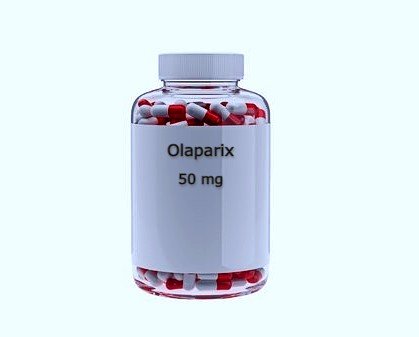
Olaparix (Olaparib) 150 MG – 120 Tablets
Price: $760.00
Olaparib use as maintenance treatment in patients with advanced ovarian cancer, fallopian tube cancer, or primary peritoneal cancer with a various type of inherited (germline) or acquired (somatic) abnormal BRCA gene. It use in patients who received complete or partial treatment with platinum-based cancer medicines.
Olaparix, is Medicine forms, in treating the people suffering from ovarian and breast cancer. Olaparib is a poly (ADP-ribose) polymerase (PARP) inhibitor that is primarily indicated in treating ovarian and breast cancer.


Description
Product Features:
| Product Name | : | Olaparix |
| Generic Name | : | Olaparib |
| Formulation | : | Tablet |
| Available Pack Size | : | 120 Tablet |
| Available Strength | : | 150 mg |
| Registrations | : | Export Only |
| Website | : | Olaparix.com |
Olaparix (Olaparib) is a medicine to take by mouth twice daily with or without food. Try to space your doses about 12 hours apart. Take Olaparix at around the same times every day. Follow the instruction on your prescription label carefully, and ask your doctor or pharmacist to explain any part if you do not understand. Take olaparib exactly as instructed . Do not take more or less of it or take it more often than prescribed by your doctor.
Swallow the tablet or capsule whole; do not crush chew, divide, or dissolve them.
Olaparix is available as a tablet and as a capsule. The tablets and capsules contain different amounts of olaparib and should not be substituted for one another. Talk to your doctor or pharmacist if you have any questions about the tablet and capsule preparations.
Indications
Breast Cancer: Olaparix (Olaparib) indicate as monotherapy for the treatment of adult patients with deleterious or suspected deleterious germline BRCA-mutated (gBRCAm), human epidermal growth factor receptor 2 (HER2)-negative metastatic breast cancer who have previously been treated with chemotherapy in the neoadjuvant, adjuvant or metastatic setting. Patients with hormone receptor (HR)-positive breast cancer should have progressed on or be considered inappropriate for endocrine therapy. Germline BRCA mutation must be confirmed before Olaparib treatment is initiated.
Ovarian Cancer: Olaparix (Olaparib) indicate as monotherapy for the maintenance treatment of adult patients with platinum sensitive relapsed (PSR) high-grade epithelial ovarian, fallopian tube or primary peritoneal cancer who are in response (complete response or partial response) to platinum based chemotherapy.
Pharmacology
Dosage & Administration
There is a risk of medication errors between Olaparib tablets and Olaparib capsules. In order to minimize this risk, check the bottle labels to ensure that the drug being prepare and dispense is Olaparib tablets and not Olaparib capsules. Prescribers should specify the formulation and dosage of Olaparib on each prescription.
The recommended total daily dose of Olaparix (Olaparib) tablets is 600 mg, taken as two 150 mg tablets twice daily. The 100 mg tablet is available for dose reduction.
For treatment of ovarian cancer: Patients start treatment with Olaparib no later than 8 weeks after completion of their final dose of the platinum-containing regimen. Patients should have recovered from prior hematologic toxicities prior to starting Olaparib therapy (hemoglobin, platelet, and neutrophil levels should be ≤ CTCAE grade 1).
It recommend that Olaparib treatment continue until progression of the underlying disease or unacceptable toxicity. Olaparib should not given in combination with other anti cancer therapy. Grapefruit or other similar fruit juices that known to inhibit CYP3A should not consume while taking Olaparib.
Interaction
Contraindications
Side Effects
Pregnancy & Lactation
Pregnancy: Olaparib can cause fetal harm when administered to a pregnant woman base on its mechanism of action and findings in animals. Olaparib wasteratogenic and cause embryo-fetal toxicity in rats at exposures below those in patients receiving the recommended human dose of 400 mg twice daily. While this drug use during pregnancy, or if a patient becomes pregnant while taking this drug, apprise the patient of the potential hazard to the fetus and the potential risk for loss of the pregnancy.
Nursing Mothers: It is not known whether olaparib excrete in human milk. Because many drugs excrete in human milk and because of the potential for serious adverse reactions in nursing infants from olaparib, a decision should made whether to discontinue nursing or to discontinue the drug, taking into account the importance of the drug to the mother.
Precautions & Warnings
Myelodysplastic Syndrome/Acute Myeloid Leukemia (MDS/AML): occurred in patients exposed to Olaparib, and the majority of reports were fatal. Monitor patients for hematological toxicity at baseline and monthly thereafter. Discontinue if MDS/AML confirm.
Pneumonitis: This occurred in patients expose to Olaparib, and some cases fatal. Interrupt treatment if pneumonitis suspected. Discontinue if pneumonitis confirm.
Embryo-Fetal Toxicity: Olaparib can cause fetal harm. Advise females of reproductive potential of the potential risk to a fetus and to use effective contraception.
Use in Special Populations
Overdose Effects
Storage Conditions
Store in a dry place below 30°C, protect from light. Keep out of the reach of children.












Reviews
There are no reviews yet.